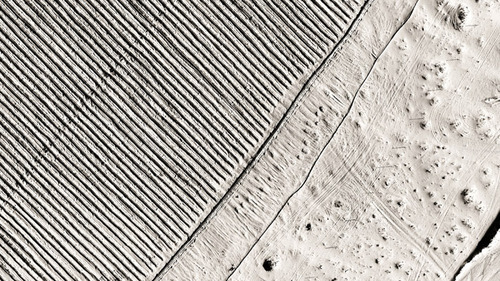Jananne Al-Ani’s: Shadow Sites II Shadow Sites II is a film by JANANNE AL-ANI t
Jananne Al-Ani’s: Shadow Sites IIShadow Sites II is a film by JANANNE AL-ANI that takes the form of an aerial journey. The image pans towards abstract panoramas – oddly-shaped and human-less patterns, quadrangles and grids criss-crossing the surface of the land: the markers of habitation contemporary and ancient; traces of activity.In response to the military’s use of digital technology and satellite navigation, AL-ANI produces a film that recreates the aerial vantage point of such missions while taking an altogether different viewpoint of the land it surveys. The film burrows into the landscape as one image slowly dissolves into another, like a mineshaft tunneling deep into a substrate of memories preserved over time.The prominent role of digital technology in the 1991 Desert Storm campaign was a watershed in the history of warfare and changed the way war was to be seen in the future. Within hours of the Iraqi invasion of Kuwait, the Western media machine had mobilized its forces and set its sights firmly on the region. Through the portrayal of the population, the culture and, crucially, the landscape of the Middle East, it revealed that the nineteenth-century Orientalist stereotype of the Arab and the desert remained firmly embedded in Western consciousness. The site of the war was shown to be a desert, a place with no history and no population—an empty space, a blank canvas. (Jananne Al-Ani, “Acting Out” in Veil: Veiling, Representation and Contemporary Art, MIT press, 2003)Further descriptions via smithsonianmag[…]“I was very interested in the idea of the disappearance of the body in the landscape through crime, genocide and massacre but also in the idea of the artist trying to remove himself or his presence from the image,” explains Al-Ani, contemplating the persistent desolation that carries into her work as well.[…] Using research collections from the Air and Space museum on military technology and the Sackler’s collection of Herzfeld’s photographs, Al-Ani was able to highlight the ambiguity of both military surveillance images and archaeological documents. Describing Herzfeld’s records, she says, “I thought his work was very interesting because often he photographed his journey to the site, or the site from such a distance, that you’d almost not be able to see what the subject of the photograph was. They became kind of autonomous landscapes.” -- source link
Tumblr Blog : 5centsapound.tumblr.com
#jananne al-ani









